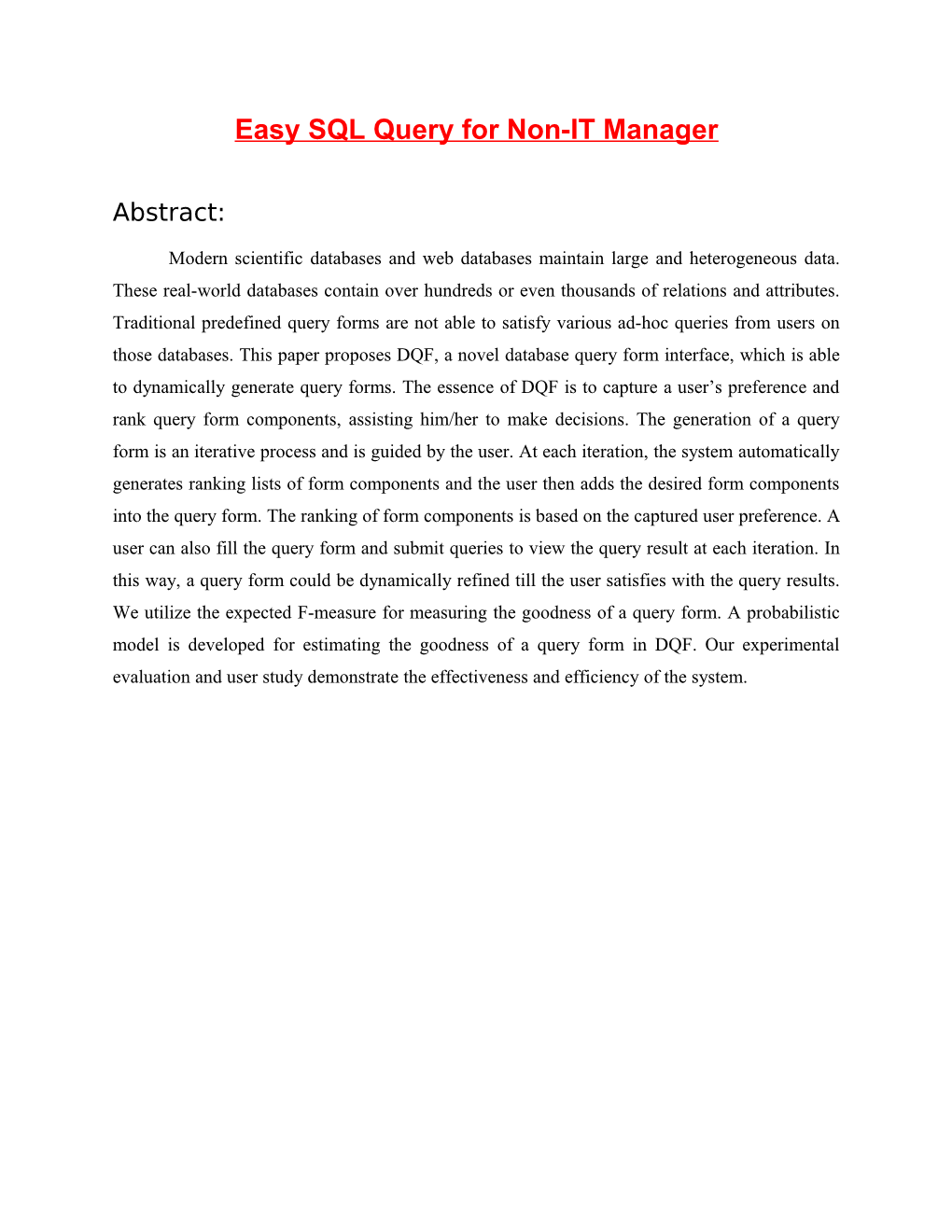Easy SQL Query for Non-IT Manager
Abstract:
Modern scientific databases and web databases maintain large and heterogeneous data. These real-world databasescontain over hundreds or even thousands of relations and attributes. Traditional predefined query forms are not able to satisfyvarious ad-hoc queries from users on those databases. This paper proposes DQF, a novel database query form interface, which isable to dynamically generate query forms. The essence of DQF is to capture a user’s preference and rank query form components,assisting him/her to make decisions. The generation of a query form is an iterative process and is guided by the user. Ateach iteration, the system automatically generates ranking lists of form components and the user then adds the desired formcomponents into the query form. The ranking of form components is based on the captured user preference. A user can alsofill the query form and submit queries to view the query result at each iteration. In this way, a query form could be dynamicallyrefined till the user satisfies with the query results. We utilize the expected F-measure for measuring the goodness of a queryform. A probabilistic model is developed for estimating the goodness of a query form in DQF. Our experimental evaluation anduser study demonstrate the effectiveness and efficiency of the system.
Existing System:
Recently proposed automatic approaches to generate the databasequery forms without user participation presented a data-driven method. It first finds a set of data attributes, which are most likely queried based on the database schema and data instances. Then, the query forms are generated based on the selected attributes. One problem of the aforementioned approaches is that, if the databaseschema is large and complex, user queries could be quite diverse. In that case, even if we generate lots of query forms in advance, there are still user queries that cannot be satisfied by any one of query forms. Another problem is that, when we generate a large number of query forms, how to let users find an appropriate and desired query form would be challenging. A solution that combines keyword search with query form generation is proposed. It automatically generates a lot of query formsin advance. The user inputs several keywords to find relevant query forms from a large number of pre-generated query forms. It works well in the databases which have rich textual information in data tuples and schemas. However, it is not appropriate when the user does not have concrete keywords to describe the queries at the beginning, especially for the numeric attributes.
Proposed System:
we propose a Dynamic Query Form system:DQF, a query interface which is capable of dynamically generating query forms for users. Different from traditional document retrieval, users in database retrieval are often willing to perform many rounds of actions (i.e., refining query conditions) before identifying the final candidates. The essence ofDQF is to capture user interests during user interactions and to adapt the query form iteratively. Each iteration consists of two types of user interactions: Query Form Enrichment and Query Execution.
The following figure shows the work-flow of DQF . It starts with abasic query form which contains very few primary attributes of the database. The basic query form is then enriched iteratively via the interactions between the user and our system until the user is satisfied with the query results.
System architecture
Modules:
The system is proposed to have the following modules along with functional requirements.
- Query Form Enrichment
- Query Execution
- Customized Query Form
- Database Query Recommendation
1. Query Form Enrichment
1)DQF recommends a ranked list of query form components to the user.
2) The user selects the desired form components into the current query form.
2. Query execution
1) The user fills out the current query form and submit a query.
2) DQF executes the query and shows the results.
3) The user provides the feedback about the query results.
3. Customized Query Form
They provide visual interfaces for developers to createor customize query forms. The problem of those toolsis that, they are provided for the professional developers who are familiar with their databases, not for end-users. Ifproposed a system which allowsend-users to customize the existing query form at runtime. However, an end-user may not be familiar withthe database. If the database schema is very large, it isdifficult for them to find appropriate database entitiesand attributes and to create desired query forms.
4.Database Query Recommendation
Recent studiesintroduce collaborative approaches to recommenddatabase query components for database exploration. They treat SQL queries as items in the collaborative filtering approach, and recommend similarqueries to related users.
System Configuration
H/W System Configuration:
Processor - Pentium –III
Speed - 1.1 Ghz
RAM - 256 MB(min)
Hard Disk - 20 GB
Floppy Drive - 1.44 MB
Key Board - Standard Windows Keyboard
Mouse - Two or Three Button Mouse
Monitor - SVGA
S/W System Configuration:
Operating System :Windows95/98/2000/XP
Technology : JAVA, JFC(Swing),J2me
Database : Mysql
Database Connectivity : JDBC.
CONCLUSION AND FUTURE WORK
In this paper we propose a dynamic query formgeneration approach which helps users dynamicallygenerate query forms. The key idea is to use a probabilisticmodel to rank form components based on userpreferences. We capture user preference using bothhistorical queries and run-time feedback such as clickthrough.Experimental results show that the dynamicapproach often leads to higher success rate and simplerquery forms compared with a static approach.The ranking of form components also makes it easierfor users to customize query forms. As future work,we will study how our approach can be extended tonon relational data.
